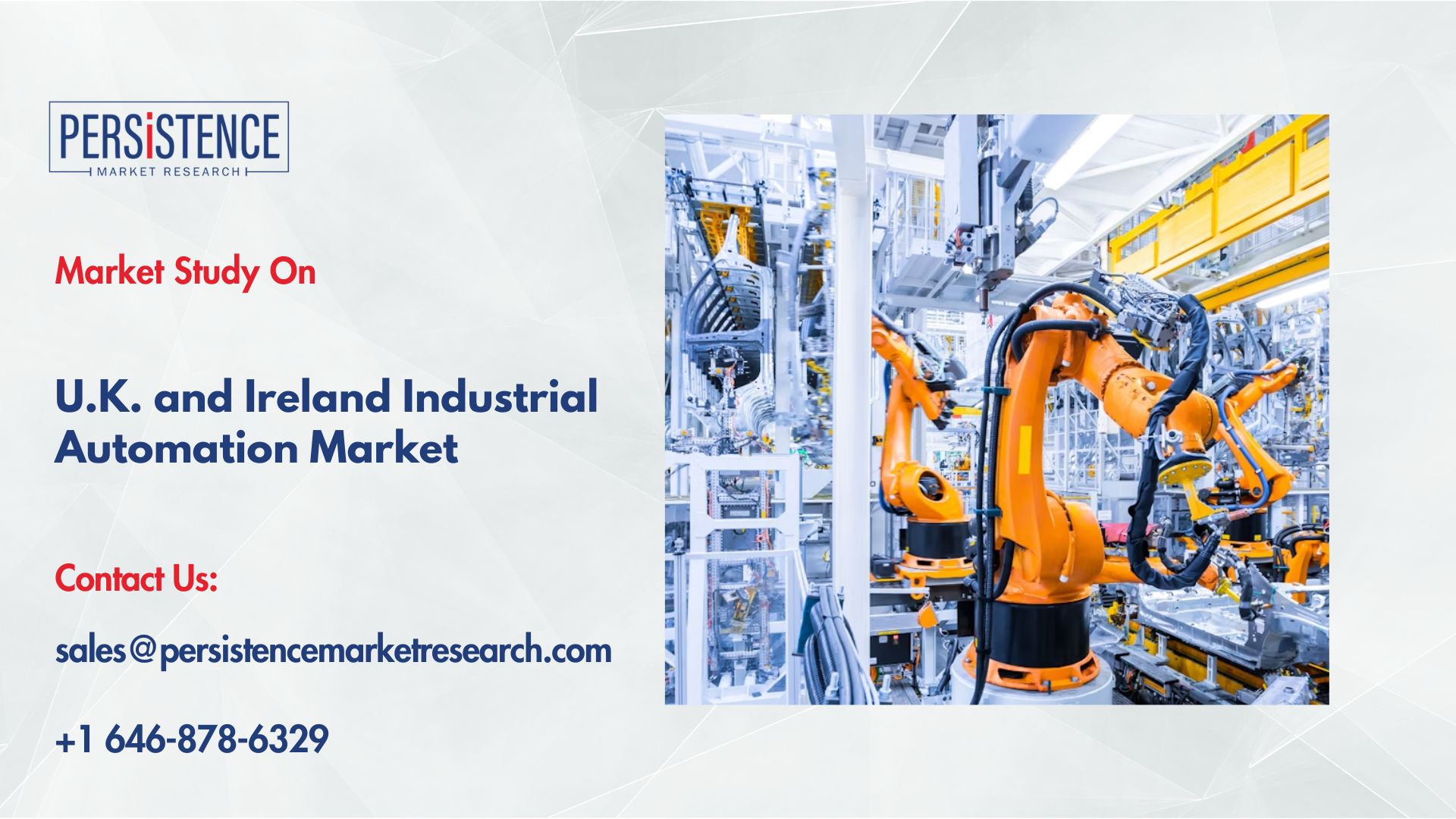U.K. and Ireland Industrial Automation Market Driven by Smart Manufacturing

Strong 8k brings an ultra-HD IPTV experience to your living room and your pocket.
U.K. and Ireland Industrial Automation Market: Size, Trends, and Future Outlook (2025–2032)
The U.K. and Ireland industrial automation market is poised for remarkable growth, with its value projected to increase from US$ 12.2 billion in 2025 to US$ 19.9 billion by 2032, reflecting a compound annual growth rate (CAGR) of 7.2% during the forecast period. This growth trajectory is shaped by a confluence of technological innovations, shifting labor dynamics, rising operational costs, and strong government support for digital transformation.
The U.K. and Ireland industrial automation market is undergoing a foundational shift, transforming from traditional manufacturing frameworks into digitized, smart production ecosystems. This transformation is most visible in sectors like pharmaceuticals, food and beverage, and logistics—industries that are heavily reliant on process precision, cleanliness, and operational efficiency. Industrial automation technologies, including robotics, artificial intelligence (AI), and the Industrial Internet of Things (IIoT), are playing a crucial role in redefining production capabilities across the region.
Driving Forces Behind Market Growth
The primary driver fueling the expansion of industrial automation in the U.K. and Ireland is the rising cost of labor and energy. Manufacturers are actively seeking solutions to streamline operations, reduce resource consumption, and mitigate disruptions caused by labor shortages. For instance, companies like Princes Group have adopted automation technologies such as automated Clean-In-Place (CIP) systems, which led to a 20% reduction in water usage and a 15% decrease in cleaning cycle times—translating into substantial cost savings.
In Ireland, the situation is even more acute within the pharmaceutical and medtech sectors. As global demand for pharmaceuticals continues to surge, Irish manufacturers are integrating robotics and process automation technologies to increase throughput without expanding their workforce. Boston Scientific’s adoption of robotic systems and machine vision in its Cork facility has not only improved efficiency but also significantly reduced errors and downtime, resulting in an 8% boost in Overall Equipment Effectiveness (OEE).
Moreover, programs such as the Irish Manufacturing Research (IMR) pilot have shown that even small and medium-sized enterprises (SMEs) can benefit from automation. Participants in these programs reported a 25% reduction in waste and a 10–12% increase in throughput within the first year of automation integration.
Challenges and Market Restraints
Despite its promising outlook, the industrial automation market in the U.K. and Ireland faces notable challenges. One of the major obstacles is the legacy infrastructure that dominates many manufacturing environments. In particular, older facilities in sectors such as textiles and food processing often lack the digital maturity needed to integrate modern automation solutions seamlessly. These aging systems often require expensive retrofits and custom interfaces, increasing the upfront capital needed for transformation.
A 2023 survey by Make U.K. found that over 40% of small manufacturers still rely on outdated equipment incompatible with modern automation interfaces. This limits their ability to transition to more advanced technologies such as predictive maintenance, machine vision, and real-time process optimization.
In Ireland, indigenous manufacturers in SME-heavy sectors, such as agri-food and precision machining, face similar hurdles. While multinational corporations operating in Ireland benefit from state-of-the-art facilities and cleanroom environments, local businesses are often lagging in basic digitization. IMR data indicates that fewer than 30% of small Irish manufacturers have adopted even basic sensor networks or Manufacturing Execution Systems (MES), making it challenging to scale toward smart automation.
Additionally, capital constraints continue to be a pressing concern. With inflationary pressures and economic uncertainties, many SMEs are reluctant to invest heavily in automation technology, especially when the return on investment may not be immediately evident.
5G Networks: A Catalyst for Change
One of the most significant opportunities emerging in the market is the advent of 5G technology. Ultra-low-latency wireless communication enables real-time data transmission, remote machine operation, and seamless integration of a vast network of connected devices.
In the U.K., the Manufacturing Technology Center (MTC) in Coventry, in collaboration with BT and Ericsson, has established a 5G-enabled testbed to explore the potential of real-time robotic control and augmented reality in factory environments. Results from these pilot projects indicate that 5G can reduce robotic control latency to under 10 milliseconds, allowing for advanced use cases such as mobile robot fleets and remote diagnostics.
Ireland is also exploring private 5G networks to enhance production agility. Manufacturers have started using 5G to connect Autonomous Guided Vehicles (AGVs), real-time sensors, and digital twins across production lines. The initial results are impressive, with a reported 30% improvement in quality monitoring and a 25% reduction in changeover times. This paves the way for flexible batch manufacturing, particularly critical in high-mix, low-volume sectors like pharmaceuticals and food production.
Segmental Insights: Components and Technologies
The U.K. and Ireland industrial automation market can be broadly segmented by components and technologies.
On a component level, hardware dominates the market, accounting for approximately 62.7% of the total share in 2025. The demand is driven by the region’s heavy reliance on machinery, robotics, and programmable controllers. Industries such as automotive, aerospace, and food processing are major consumers of Programmable Logic Controllers (PLCs), Human-Machine Interfaces (HMIs), and robotic arms, which are critical for achieving productivity improvements.
Software, while smaller in share, is growing rapidly. As manufacturers move toward more agile and data-driven production, platforms such as MES, SCADA, and analytics tools are becoming indispensable. In Ireland, software adoption is accelerating within the pharmaceutical and medtech sectors, where regulatory compliance, traceability, and data integrity are non-negotiable.
From a technology standpoint, industrial robotics leads the charge, expected to capture around 28.4% of the market in 2025. The rise of collaborative robots (cobots) is particularly noteworthy—they are safer, more affordable, and easier to integrate than traditional robotic systems, making them ideal for SMEs with constrained resources.
Other prominent technologies include:
• Machine Vision Systems, used for real-time quality control and inspection
• Artificial Intelligence and Machine Learning, enabling predictive maintenance and process optimization
• Industrial Internet of Things (IIoT), which connects assets and equipment to enable data-driven decision-making
• Advanced Process Control (APC) and HMI, critical for managing complex manufacturing environments with real-time control and visibility
Country-specific Insights
United Kingdom Market Dynamics
The U.K. has lagged in industrial automation adoption compared to its G7 counterparts, especially in terms of robot density. According to the International Federation of Robotics, the U.K. had just 111 robots per 10,000 employees in 2023, compared to Germany’s 397 and Italy’s 224. However, this gap is closing, particularly in the aerospace and pharmaceutical sectors.
The Made Smarter initiative by the U.K. government is a driving force behind this improvement. Through financial support, training programs, and expert consultations, the initiative is helping SMEs across regions like the Northwest and the Midlands adopt industrial automation. Engineering firms in Greater Manchester have reported productivity gains of up to 15% after integrating IoT platforms and robotics.
Ireland Market Dynamics
Ireland has emerged as a regional leader in automation, largely due to its focused Industry 4.0 roadmap, which was launched in 2020 and aims for full implementation by 2025. Backed by €6 billion in investment, the strategy focuses on building a collaborative ecosystem among academia, government, and industry players.
Pharmaceutical companies such as Eli Lilly, MSD, and Boston Scientific are at the forefront of automation in Ireland, integrating robotics in quality control, lab automation, and packaging. This shift is not only enhancing operational efficiency but also contributing to the onshoring of manufacturing operations, further strengthening Ireland’s industrial base.
Local engineering firms like Noreside Engineering are playing a key role in integrating automation solutions into the pharmaceutical landscape. Ireland’s combination of a skilled workforce, a strong R&D infrastructure, and a favorable regulatory environment makes it a fertile ground for automation innovation.
Competitive Landscape
The U.K. and Ireland industrial automation market is highly competitive and fragmented, with participation from global technology giants and local system integrators. Key players include Siemens, ABB, Rockwell Automation, Schneider Electric, and Honeywell, all of whom have established a strong foothold in the region.
What makes this market unique is the significant presence of regional system integrators and start-ups, who offer customized solutions tailored to legacy infrastructure. These local players are particularly critical for SMEs that require retrofitting rather than greenfield automation projects. They often provide end-to-end services—from system design to implementation and training.
Cybersecurity is becoming a key differentiator among automation providers. As operational technology (OT) systems become increasingly connected, they also become more vulnerable to cyber threats. Vendors that offer built-in OT security features—such as intrusion detection, role-based access control, and encrypted communication—are gaining favor among manufacturers with sensitive production data.
Future Outlook
Looking ahead, the U.K. and Ireland industrial automation market is well-positioned for sustained growth. Several trends will shape its evolution:
• Human-centric automation, blending human expertise with robotic efficiency
• Energy optimization technologies, aimed at achieving sustainability targets
• Digital twins, enabling real-time simulation and process optimization
• Scalable cloud platforms, fostering remote monitoring and predictive analytics
Government support will remain a pivotal factor in driving automation adoption. As policy frameworks such as Made Smarter in the U.K. and Industry 4.0/5.0 roadmaps in Ireland mature, they will serve as catalysts for broader implementation.
In conclusion, the U.K. and Ireland industrial automation market is transitioning from promise to performance. Backed by technology, policy, and pressing industrial needs, automation is becoming not just a strategic advantage but a necessary pillar for manufacturing competitiveness in the region. Stakeholders who invest early and wisely in automation will be best positioned to thrive in this rapidly changing landscape.
𝐄𝐱𝐩𝐥𝐨𝐫𝐞 𝐭𝐡𝐞 𝐋𝐚𝐭𝐞𝐬𝐭 𝐓𝐫𝐞𝐧𝐝𝐢𝐧𝐠 𝐑𝐞𝐩𝐨𝐫𝐭:
High Pressure Fixed Firefighting Misting System Market
Blast Monitoring Equipment Market
Note: IndiBlogHub features both user-submitted and editorial content. We do not verify third-party contributions. Read our Disclaimer and Privacy Policyfor details.







